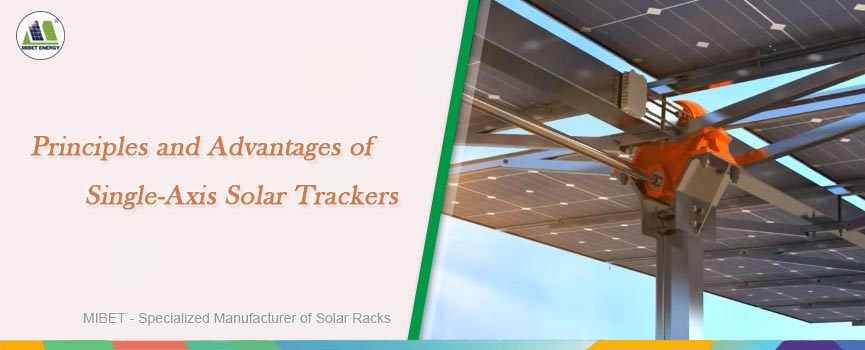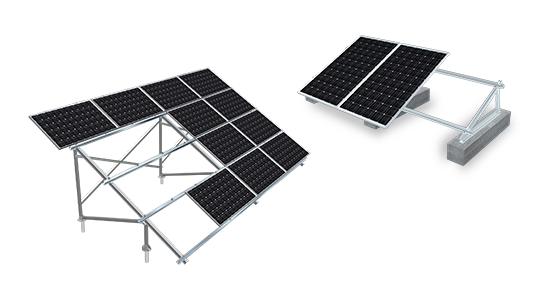Principles and Advantages of Single-Axis Solar Trackers

The sun shifts continually in the sky, altering its location both daily and seasonally. Adjusting the angle of solar panels in a PV system to align with the sun's current position can significantly enhance energy output. Single-axis solar trackers are designed for this purpose. This blog post will introduce the working principle and advantages of single-axis solar trackers, as well as other information you need to know.
What Is a Single-axis Solar Tracker?
A single-axis solar tracker is a device that rotates on one axis to follow the sun's path across the sky. When combined with solar panels, this tracker allows the panels to align with the sun's trajectory, thereby capturing more sunlight and generating additional renewable energy for your use. This setup significantly boosts the amount of sunlight absorbed by the panels, enhancing energy production over fixed-tilt systems.
The angle at which sunlight hits a solar panel directly impacts its energy production. A more direct, perpendicular angle allows the panel to convert more sunlight into electricity. By constantly adjusting the panel's orientation, single-axis trackers ensure a consistently optimal angle, leading to higher energy output compared to stationary panels.
While the initial setup and ongoing upkeep of a single-axis tracker come with costs, the increased energy production can often offset these expenses over time. For optimal performance, it's advisable to install these trackers on level terrain in regions that are typically warm and dry.
The Working Principle of Single-Axis Solar Trackers

The working principle of single-axis solar trackers involves a combination of mechanical, electronic, and software components that enable solar panels to follow the sun's path across the sky, optimizing the amount of sunlight captured and thereby increasing the energy output.
Axis of Rotation
1. Azimuth Tracking (HSAT): These trackers rotate around a vertical axis, similar to a compass needle, to follow the sun's movement from east to west across the sky.
2. Altitude Tracking (VSAT): These trackers rotate around a horizontal east-west axis, adjusting the tilt of the solar panels to accommodate the sun's changing elevation in the sky throughout the day and over different seasons.
Structural Framework
1. Wind Loads: A sturdy framework is crucial to withstand wind loads, particularly in high wind areas, as trackers present a larger surface area to the wind compared to fixed systems.
2. Backtracking: Some systems employ backtracking algorithms to prevent shading of one row of panels by another, especially useful in the early morning and late afternoon.
Drive Mechanism
1. Motors and Gearing: Common in larger systems, these components adjust the panels' position as needed.
2. Linear Actuators: Used particularly in smaller or residential systems, offering precise movement.
3. Tracking Speed: The mechanism's speed is calibrated to match the sun's apparent movement, which is approximately 15 degrees per hour, ensuring smooth and continuous tracking.
Control System
1. Sensors: Photoresistors (LDRs) are cost-effective but can perform poorly in extreme temperatures, while photodiodes are more accurate and less temperature-sensitive, making them a superior choice for variable climates.
2. Astronomical Clock: In simpler or less expensive systems, this clock can eliminate the need for real-time solar position sensors by using pre-programmed sun position data for basic time-based tracking.
Software
1. Data Acquisition: Real-time data from sensors or GPS is crucial for accurate tracking and adjusting the panels' positions.
2. Communication Protocols: Systems often require robust communication protocols like Modbus or RS-485 to facilitate efficient data exchange between the controller and other components.
Energy Supply
1. Dedicated Solar Panel: Often, a small dedicated panel powers the tracker's operations.
2. Battery Backup: A battery backup can maintain the tracker's operation during periods of low sunlight or grid outages, ensuring continuous functionality.
5 Advantages of Single-Axis Solar Trackers

1. Increased energy production
You can boost your solar energy production by 25% to 35% with single-axis trackers. By following the sun's path, these trackers ensure your panels receive optimal sunlight throughout the day, outperforming fixed-tilt systems.
2. Financially Rewarding
Investing in a solar tracker offers both financial security and attractive returns. With a payback period of 5 to 10 years, these systems can generate significant profits for two decades or more.
3. Location
Solar trackers are particularly well-suited for high-latitude locations where the sun's position shifts dramatically throughout the year. Their ability to adjust to these seasonal changes ensures maximum solar energy capture regardless of your geographic location.
4. Optimal Use of Sunlight
Capitalize on extended sunlight hours with solar tracking technology. By capturing more sunlight during the early morning and late afternoon, you further optimize the system's performance and maximize your energy production potential.
5. Reduced Space Requirements
Single-axis solar trackers utilize space more effectively than fixed arrays by allowing for more compact installation layouts. This spatial efficiency is particularly beneficial in areas where land is expensive or scarce. With trackers, you can install fewer panels to achieve the same energy output as a larger fixed array, thereby minimizing the land required for solar projects without compromising on power generation.
What is the Cost of a Single-Axis Solar Tracker?
You'll find that using a single-axis solar tracker increases the initial investment for your PV plant. Consider a standard 4-kilowatt ground-mounted system, the baseline cost sits around $13,000. Adding tracking equipment introduces an additional cost, ranging from $500 to over $1,000 per panel.
Incorporating a single-axis tracking system to the PV array would elevate the total cost to approximately $20,000. This represents a 57% increase in cost compared to a fixed-tilt array, while the energy output only sees a potential boost of 35%.
It's also important to note that despite the higher initial costs compared to fixed solar panel systems, single-axis trackers can offer higher efficiency and greater returns on investment over time due to increased energy production.
Is a Solar Tracking System Suitable for You?

For most homeowners, a rooftop installation proves the most practical and cost-effective solution. Rooftop panels require no dedicated yard space and, with a south-facing orientation, can capture ample sunlight throughout the day. This often negates the need for a tracking system. Focusing your investment on high-efficiency panels may provide a better return than adding a tracking mechanism.
Solar trackers are particularly beneficial in regions with high latitudes due to the significant annual shifts in the sun's position. Residents of Alaska and certain northern areas of the lower 48 states might find it advantageous to integrate trackers into their systems.
However, for the majority of U.S. residents, the sun's trajectory doesn't significantly hinder panel production enough to warrant a tracking system. A well-positioned rooftop array or a fixed, south-facing ground system often proves sufficient.
Large-scale commercial solar projects, on the other hand, frequently utilize trackers. In these megawatt-sized installations, the long-term gains in energy production outweigh the initial investment and maintenance costs. Most commercial solar projects are installed on the ground, which facilitates the use of solar trackers.
Interested in Installing Single-axis Solar Trackers?
If you are contemplating the use of single-axis solar trackers for your renewable energy project, Mibet's team of specialists is ready to assist you. We offer guidance tailored to the specific requirements of your facility. To initiate your commercial solar project using single-axis trackers, please reach out to us today.
Why Trust Us?

As a leading provider in the renewable energy sector, Mibet delivers advanced trackers, structures, and control systems for large-scale solar power plants worldwide. Our solar tracking systems adapt to various settings and accommodate both 1P and 2P configurations. These systems boost the efficiency of power generation and lower the Levelized Cost of Energy (LCOE). Additionally, they include monitoring features that oversee both components and processes, allowing for precise control and early detection of potential issues.
Useful Links
1. Media Coverage:
● https://www.pv-magazine.com/press-releases/mibet-energy-enters-strategic-engineering-cooperation-with-gamcorp/
● https://www.pv-magazine.com/press-releases/strategic-alliance-mibet-energy-partners-with-zing-energy-to-bolster-floating-solar-solutions-and-services-in-israel/
2. Mibet Tracking System: https://www.mbt-energy.com/products/ground-pv/tracking-pv


